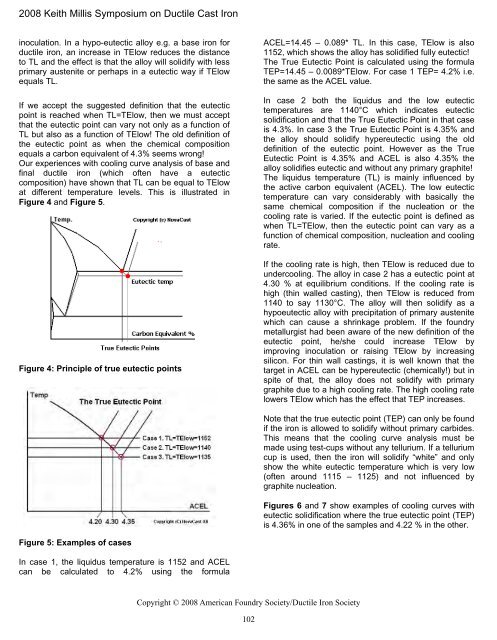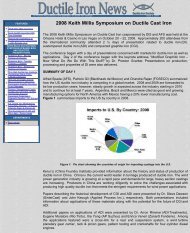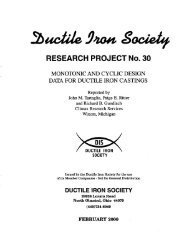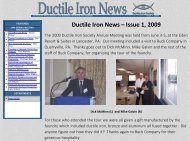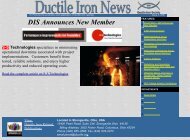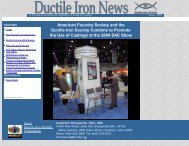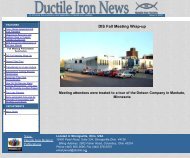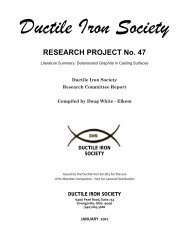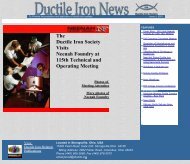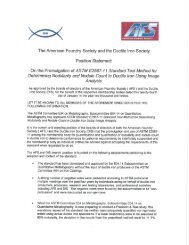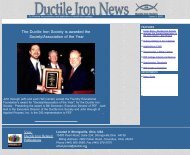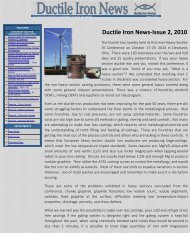Create successful ePaper yourself
Turn your PDF publications into a flip-book with our unique Google optimized e-Paper software.
2008 Keith Millis Symposium on <strong>Ductile</strong> Cast <strong>Iron</strong><br />
inoculation. In a hypo-eutectic alloy e.g. a base iron for<br />
ductile iron, an increase in TElow reduces the distance<br />
to TL and the effect is that the alloy will solidify with less<br />
primary austenite or perhaps in a eutectic way if TElow<br />
equals TL.<br />
If we accept the suggested definition that the eutectic<br />
point is reached when TL=TElow, then we must accept<br />
that the eutectic point can vary not only as a function of<br />
TL but also as a function of TElow! The old definition of<br />
the eutectic point as when the chemical composition<br />
equals a carbon equivalent of 4.3% seems wrong!<br />
Our experiences with cooling curve analysis of base and<br />
final ductile iron (which often have a eutectic<br />
composition) have shown that TL can be equal to TElow<br />
at different temperature levels. This is illustrated in<br />
Figure 4 and Figure 5.<br />
Figure 4: Principle of true eutectic points<br />
ACEL=14.45 – 0.089* TL. In this case, TElow is also<br />
1152, which shows the alloy has solidified fully eutectic!<br />
The True Eutectic Point is calculated using the formula<br />
TEP=14.45 – 0.0089*TElow. For case 1 TEP= 4.2% i.e.<br />
the same as the ACEL value.<br />
In case 2 both the liquidus and the low eutectic<br />
temperatures are 1140°C which indicates eutectic<br />
solidification and that the True Eutectic Point in that case<br />
is 4.3%. In case 3 the True Eutectic Point is 4.35% and<br />
the alloy should solidify hypereutectic using the old<br />
definition of the eutectic point. However as the True<br />
Eutectic Point is 4.35% and ACEL is also 4.35% the<br />
alloy solidifies eutectic and without any primary graphite!<br />
The liquidus temperature (TL) is mainly influenced by<br />
the active carbon equivalent (ACEL). The low eutectic<br />
temperature can vary considerably with basically the<br />
same chemical composition if the nucleation or the<br />
cooling rate is varied. If the eutectic point is defined as<br />
when TL=TElow, then the eutectic point can vary as a<br />
function of chemical composition, nucleation and cooling<br />
rate.<br />
If the cooling rate is high, then TElow is reduced due to<br />
undercooling. The alloy in case 2 has a eutectic point at<br />
4.30 % at equilibrium conditions. If the cooling rate is<br />
high (thin walled casting), then TElow is reduced from<br />
1140 to say 1130°C. The alloy will then solidify as a<br />
hypoeutectic alloy with precipitation of primary austenite<br />
which can cause a shrinkage problem. If the foundry<br />
metallurgist had been aware of the new definition of the<br />
eutectic point, he/she could increase TElow by<br />
improving inoculation or raising TElow by increasing<br />
silicon. For thin wall castings, it is well known that the<br />
target in ACEL can be hypereutectic (chemically!) but in<br />
spite of that, the alloy does not solidify with primary<br />
graphite due to a high cooling rate. The high cooling rate<br />
lowers TElow which has the effect that TEP increases.<br />
Note that the true eutectic point (TEP) can only be found<br />
if the iron is allowed to solidify without primary carbides.<br />
This means that the cooling curve analysis must be<br />
made using test-cups without any tellurium. If a tellurium<br />
cup is used, then the iron will solidify “white” and only<br />
show the white eutectic temperature which is very low<br />
(often around 1115 – 1125) and not influenced by<br />
graphite nucleation.<br />
Figures 6 and 7 show examples of cooling curves with<br />
eutectic solidification where the true eutectic point (TEP)<br />
is 4.36% in one of the samples and 4.22 % in the other.<br />
Figure 5: Examples of cases<br />
In case 1, the liquidus temperature is 1152 and ACEL<br />
can be calculated to 4.2% using the formula<br />
Copyright © 2008 American Foundry <strong>Society</strong>/<strong>Ductile</strong> <strong>Iron</strong> <strong>Society</strong><br />
102


